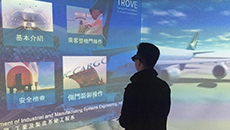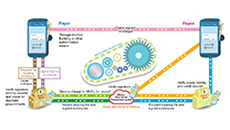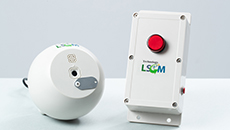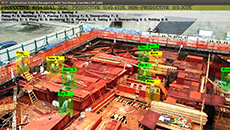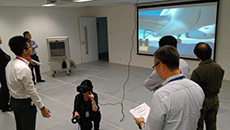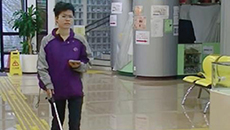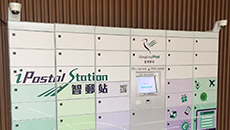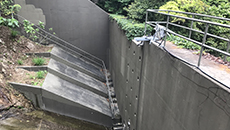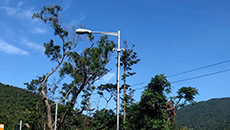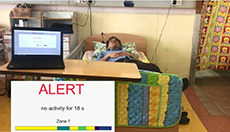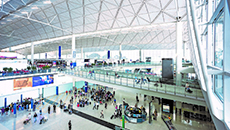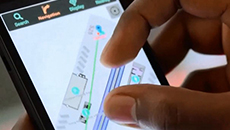The LSCM R&D programmes are demand-driven. With collaboration among academia and industry, a number of research projects have been successfully developed and adopted by the industry players to increase productivity and efficiency.
A Virtual Reality System for Strategic Operations Training 
LSCM has worked with the University of Hong Kong to develop a fully immersive cave automatic virtual environment that provides the capabilities for professionals to experience the life-like scenarios of complex operations and interact dynamically with such environment. Activities are recorded and behavior analyzed in real-time is developed.
The virtual reality training system represents a state-of-the-art design of capitalizing the virtual reality technology with artificial intelligence methods to deliver an integrated system that create a cost effective, versatile and reconfigurable, interactive and immersive training environment that readily supports evidence and discovery-based training in operation planning and decision making.
The technology has been used in two pilot cases: The first one is a ramp operation training system that is developed in collaboration with Cathay Pacific Services Limited (CPSL) for the training of supervisors and operators in performing ramp operation where air cargo containers are loaded and unloaded from freight aircrafts. The system uses the imseCAVE VR system to recreate the scenarios of air cargo loading where operators use various user interfaces including a mock-up of a real-size cargo door control panel to control the operations of virtual loading systems to handle air cargo.
The second one is a VR training system built for the HK Police Force at the Detective Training Centre, Specialized Services Training Centre of the Hong Kong Police College. The system creates crime scenes where detectives can use to undergo their training programme effectively through exploration of scenarios.

E-Cheque Wallet application
Hong Kong Monetary Authority has launched e-Cheque since 2015 to replace the need of physical delivery and presentation, enhancing the circulation of credit transfer activities. E-Cheque Wallet applications developed by LSCM provide a more convenient platform for e-Cheque transactions. In contrast to most e-Wallets that use a traditional centralized ledger, LSCM E-Cheque Wallet utilizes the Blockchain technology which provides a safe and reliable system to eradicate replicated and counterfeit cheque so as to strengthen corporate’s confidence on e-Cheque.
In 2017, E-Cheque Wallet application has won the silver medal at the Geneva International Exhibition of Inventions.
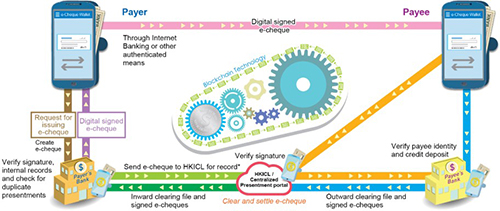
Infrared Thermal Sensing Safety Alert System for the Elderly
The Infrared Thermal Sensing Safety Alert system, which preserves personal privacy, was developed to monitor an individual’s safety in a private space. It analyses the real-time thermal data of the private space to determine whether the individual needs support from the caretakers. With the installation of the thermal sensor, this low-cost thermal sensing system detects and analyses human movement in the private space. When body movement is not detected for a pre-defined period of time, an alarm will alert the caretakers. The thermal sensor can be installed easily inside a toilet or a bathroom. The system assists the caretakers to look after the elderly in the elderly care centres and enhances the quality of the services. The pilot-run of the system has been conducted in TWGHs Jockey Club Rehabilitation Complex.
In 2019, the system won a Gold Medal at the 47th International Exhibition of Inventions Geneva. It also received a Silver Medal at the 1st Asia Exhibition of Inventions Hong Kong which was held in 2018. There were wide media coverages about the system.
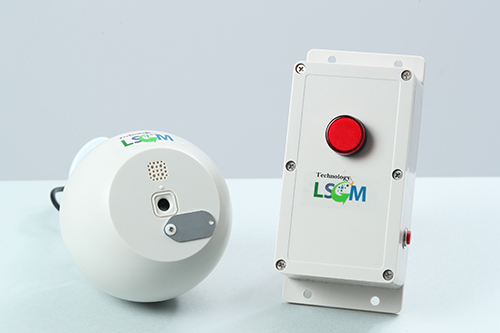
IoT Cross-Boundary Fast Clearance Security System 
Since November 2012, LSCM has assisted Hong Kong Customs in the trial of the “Single E-lock Scheme” with Mainland Customs set out to interconnect the Hong Kong Customs’ Intermodal Transshipment Facilitation Scheme (ITFS) with the Speedy Customs Clearance (SCC) of the Mainland Customs. Under the scheme, the processing time of customs clearance of registered trucks at land boundary control points can be reduced by up to two hours.
Up to now, the scheme has been extended to 32 clearance points in Guangdong province including Guangzhou Nansha Free Trade Zone, Jiangmen International Electronic Commerce Express Mail Sorting Clearance Centre, as well as the Guangzhou Baiyun International Airport and Air Logistics Park of Bao’an International Airport, including the 12 clearance points in Hong Kong, 384 express intermodal transportation routes are offered. As of February 2016, the scheme has been on trial for more than 8,400 times, with over 2.55 million consignments being handled. Since the official launching of “Single E-lock Scheme” in late March of 2016 by both Customs authorities, the IoT Cross Boundary Fast-Clearance developed by LSCM makes customs clearance between Hong Kong and Guangdong more convenient and efficient.
E-Lock has won the silver medal at the 45th Geneva International Exhibition of Inventions held from 29 March to 2 April, 2017.

Pi: A Smart Construction Quality Management System
Project Eye (Pi) is a vision-based system that integrates computer vision with deep learning to improve the current manual quality management process in construction sites. In order to determine whether there are any quality deviations and dangers in construction activities, Pi takes site surveillance videos as input to detect construction-related objects and recognise activities of workers and construction plants. It helps the quality inspectors reduce the time spent on on-site inspections and preparing paper records. Pi is non-intrusive and requires little additional cost in its implementation since surveillance cameras are commonly used in construction sites.
Pi received a Gold Medal in the 47th International Exhibition of Inventions Geneva held in 2019.
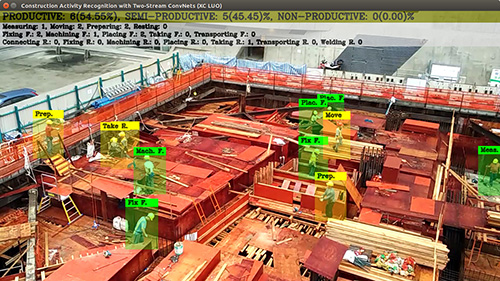
Real Virtuality for Aircraft Inspection (ReVAI) Training System
This training system was jointly developed by LSCM, China Aircraft Services Limited (CASL) and The University of Hong Kong.
A virtual reality-empowered training system was developed for the training of China Aircraft Services Limited (CASL)'s aircraft maintenance staff to perform walk-around inspections in aircraft. The inspection is a critical aircraft maintenance operation undertaken by CASL. The virtual reality (VR) training system is developed based on the technology of interactive and immersive VR training paradigm. It is powered by the imseCAVE VR solutions, together with the VR training management methodology, in the domain of aviation service logistics.
The VR-empowered training system for aircraft maintenance operation training not only enhances the availability and flexibility of the training process to a great extent, but also improves the safety of personnel in such training. Moreover, the system can analyse a trainee’s behaviour during the training process. It provides a higher standard of the skills of the trainees with enhanced flexibility, lower risk of damaging valuable hardware, and ultimately improves the cost effectiveness of a training programme.
A Silver Medal was awarded to the system at the 47th International Exhibition of Inventions of Geneva.
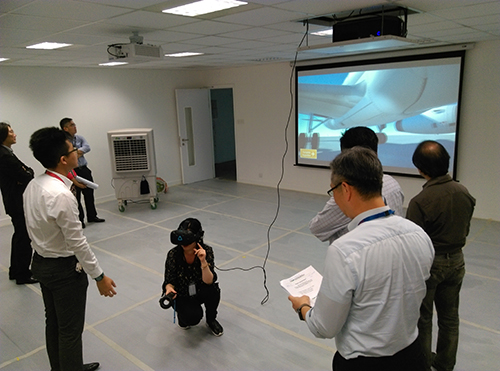
RFID Blind Cane Navigation System 
LSCM developed a Blind Cane Navigation System for the visually impaired. With RFID technology and audio navigation, the system provides guidance to the visually impaired and leads them to their destination by the shortest route. With the aid of the Blind Community Cloud Platform, the visually impaired can obtain the latest updates on the map and enjoy a seamless navigation across different regions. Functions such as item tagging are also available to make the living of visually impaired more convenient. The system was awarded the Gold Medal with Congratulations of the Jury at the 44th Geneva International Exhibition of Inventions in 2016. Barrier Free Access (HK) Limited, a wholly-owned subsidiary of The Hong Kong Society for the Blind, has also started the relevant business to offer full-set of service backing the RFID Blind Cane Navigation System. It is expected that the technology can be applied in places like shopping centres, public housing estates and streets in the near future.

RFID-enabled Parcel Locker System
In Oct 2015, LSCM conducted a research trial with the Hongkong Post to assist in the realization of the next generation of mail collection services by developing an RFID enabled parcel locker system. The first generation of iPostal station was launched in May 2016, as a system for providing lockers placed in the community which provides flexibility to the public in collecting large-sized mail at their convenience.
Currently, the Hongkong Post has deployed around 12 iPostal stations at various locations within the HKSAR. Promulgation of the new generation of RFID –enabled iPostal Stations by Hongkong Post, with the assistance of the new funding program from ITB, will allow Hongkong Post to better serve the general public. The “RFID-enabled Parcel Locker System” has won the gold medal at the Geneva International Exhibition of Inventions in 2017.

Smart Barrier
To enhance the effectiveness of the remote barriers built throughout the years by the Civil Engineering and Development Department (CEDD), the Smart Barrier has been developed. By deploying internet-of-things sensor technologies, the Smart Barrier allows real-time monitoring of falling debris and build-up. It uses a web platform and mobile application to issue instant alerts to the authority. This low cost, reliable, low power consumption system ensures real-time detection of landslide. There is an on-site Warning Message System (WMS) using the technique of Moving Message Display for alerting the residents nearby. The Smart Barrier is being deployed by the CEDD to monitor several landslide-prone areas effectively.
The Smart Barrier was one of the award-winning technologies at the 47th International Exhibition of Inventions Geneva in 2019. It was awarded a Silver Medal. The extensive media coverage on the system enabled the public to understand more about its functions and applications.
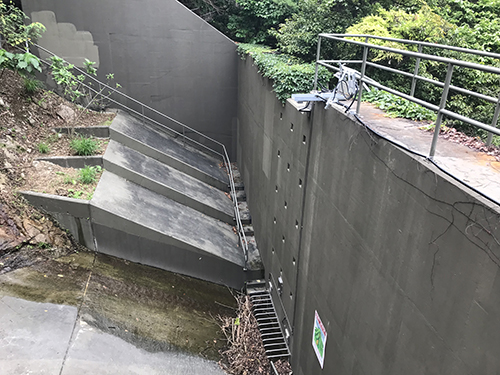
Smart Traffic Control System
The Tai Tam Road (Dam Section) was constructed more than a century ago and is part of the thoroughfare connecting Chai Wan and Stanley. As its width is only 5 meters, congestion problems often occurred when larger vehicles, with a width of 2.5 meters, used the road section. Widening the road section is not possible as the dam is a declared monument. Thus, the Smart Traffic Control System (STCS) based on video analytics (VA) technology has been developed. The system, the first of its kind in the city, has been deployed there to cut down on delays.
The STCS has 8 sets of traffic detectors installed within 400 meters of either side of the scenic but congestion-prone road. Each traffic detector turns video content into real-time traffic data by detecting, tracking, and counting vehicles passing by. The STCS then uses data from all of the 8 detectors to compute vehicle queue lengths on both sides of the Dam and adjust the duration of green traffic light signals to reduce overall delays in real time.
The system has been in commission since August 2018. According to the latest figures, it is twice as effective with time-saving compared to traditional traffic lights. Since the deployment of the STCS in 2018, the traffic queue in Tai Tam Road did not exceed 400 meters at peak hours. With a traditional traffic light, it took around 400 seconds for the vehicles to queue up and pass through the dam section while it only took around 145 seconds with the STCS in use. The system was awarded the Silver Medal in the 47th International Exhibition of Inventions Geneva held in 2019.
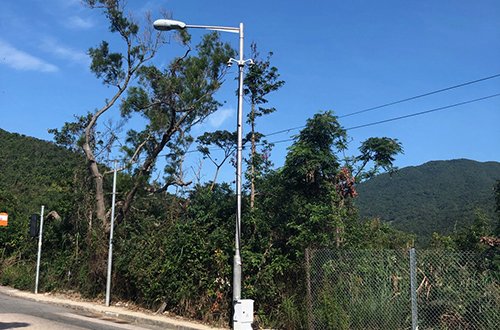
Ultra-Wideband Activity Monitoring System for Solitary Elderly
To better take care of the elderly, LSCM has developed a monitoring system to measure the activity levels of the elderly and detect any abnormal conditions by using state-of-the-art ultra-wideband (UWB) and signal processing technologies. One of the advantages of the system is that the users are not required to put on any device. The UWB radars installed in the system use sub-cm-order time-of-flight information to determine the users’ breathing rate and track their location. This low-cost system is not sensitive to the ambient conditions and is able to preserve the privacy of the elderly. As it provides real-time feedback to the caretakers, it helps them to provide remote monitoring services for the elderly efficiently.
In 2018, the system was awarded a Gold Medal at the International Exhibition of Inventions Geneva.
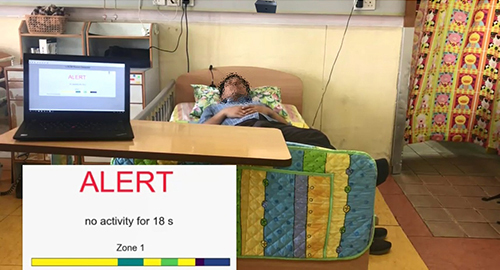
Video Analytics for Baggage Trolley Availability Monitoring and Management at Hong Kong International Airport
This real-time video-based trolley availability monitoring system has been jointly developed by LSCM and The Chinese University of Hong Kong. It is now fully deployed in the Baggage Reclaim Hall at Hong Kong International Airport. This research project uses artificial intelligence technologies to turn video imagery of baggage trolley pickup points into trolley availability data in real-time. The project also develops a trolley availability monitoring system to disseminate up-to-date trolley availability statuses via a mobile application to frontline staff. The system is to ensure sufficient trolleys are available for passengers to use.
When the number of trolleys in a pickup point drops below a certain level, the system will notify frontline staff via the mobile app. The system reduces the number of staff and the frequency to patrol all the pickup points distributing over a large floor space. It also helps frontline staff effectively replenish trolleys. The goal is to improve the quality of passenger services by ensuring trolley availability. The computed results from image analysis technology are not perfect at all. The trolley detection rate was about 87% at the early R&D stage. Through the continuously collected image data, the detection rate was able to be improved to about 92% at the end of 2016 after progressively applying corresponding machine learning technique. Since then, the system has been automatically computing numbers of trolleys over all 18 pickup points in real-time for the entire Baggage Reclaim Hall.
This trolley availability monitoring system does not require any equipment installation on any baggage trolley. This saves corresponding one-time installation procedure as well as long-term maintenance management. Via artificial intelligence technology, the system is able to extend its capability to detect other baggage trolleys of different sizes or models. Thus, Hong Kong International Airport has carried out a plan starting in 2018 to gradually extend the video-based trolley availability monitoring system to cover other trolley pickup points in arrival and departure halls.

Wherami Indoor Localisation Tracking and Navigation 
Satellite-based global positioning technologies such as the GPS and the BeiDou are easy to use. They can easily locate and assist in navigation in the outdoor areas. However, they are unsuitable for indoor environments due to poor reception of satellite signals. In light of the challenge, LSCM has collaborated with the HKUST to develop a WiFi positioning system, Wherami, for indoor localisation tracking and navigation.
This technology makes use of the widely available WiFi signals in indoor environments to develop an innovative and accurate indoor localisation tracking and navigation technology. Wherami has been on trial in the Hong Kong Airport, Cyperport and Olympian City. Through partnering with Compathnion Technology, successful trial runs have been conducted in Harbour City, followed with the official launch in the campus of the HKUST and the Union Hospital. By using any mobile device with WiFi signals, for example, shoppers can locate their exact position on indoor map at shopping mall. By searching the shop name or selecting their destination, the system navigates the shoppers to their destination with the quickest route. In addition, the system assists shoppers to access all stores in the mall, such as restaurants, banks, etc. This value-added feature is important in strengthening Hong Kong’s image as a world-class metropolis.
After successful trials, the technology has been commercialised and deployed in shopping centres including YOHO Mall, Hollywood Plaza and Ocean Terminal.
Considering the increasing demand for location-based service solutions in museums, LSCM customised the APIs to meet the requirements of museum environments and facilitate the integration into mobile applications for large-scale deployment in Tai Kwun (Hong Kong's Centre for Heritage and Art). The site comprises of three declared monuments, which are the former Central Police Station, the Central Magistracy and the Victoria Prison. Since the museum environment is markedly different from the mall environment, a different and customised calibration on the algorithms is needed to achieve optimal performance.


